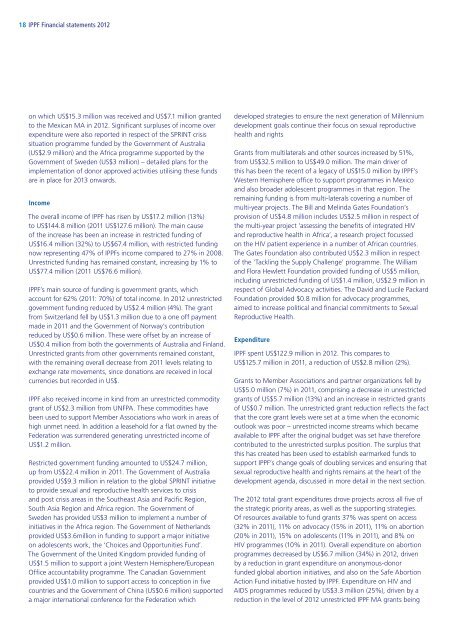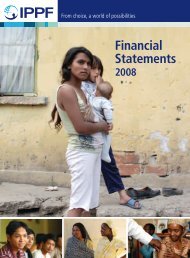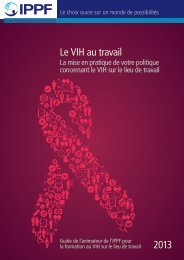Financial statements - International Planned Parenthood Federation
Financial statements - International Planned Parenthood Federation
Financial statements - International Planned Parenthood Federation
You also want an ePaper? Increase the reach of your titles
YUMPU automatically turns print PDFs into web optimized ePapers that Google loves.
18 IPPF <strong>Financial</strong> <strong>statements</strong> 2012<br />
on which US$15.3 million was received and US$7.1 million granted<br />
to the Mexican MA in 2012. Significant surpluses of income over<br />
expenditure were also reported in respect of the SPRINT crisis<br />
situation programme funded by the Government of Australia<br />
(US$2.9 million) and the Africa programme supported by the<br />
Government of Sweden (US$3 million) – detailed plans for the<br />
implementation of donor approved activities utilising these funds<br />
are in place for 2013 onwards.<br />
Income<br />
The overall income of IPPF has risen by US$17.2 million (13%)<br />
to US$144.8 million (2011 US$127.6 million). The main cause<br />
of the increase has been an increase in restricted funding of<br />
US$16.4 million (32%) to US$67.4 million, with restricted funding<br />
now representing 47% of IPPFs income compared to 27% in 2008.<br />
Unrestricted funding has remained constant, increasing by 1% to<br />
US$77.4 million (2011 US$76.6 million).<br />
IPPF’s main source of funding is government grants, which<br />
account for 62% (2011: 70%) of total income. In 2012 unrestricted<br />
government funding reduced by US$2.4 million (4%). The grant<br />
from Switzerland fell by US$1.3 million due to a one off payment<br />
made in 2011 and the Government of Norway’s contribution<br />
reduced by US$0.6 million. These were offset by an increase of<br />
US$0.4 million from both the governments of Australia and Finland.<br />
Unrestricted grants from other governments remained constant,<br />
with the remaining overall decrease from 2011 levels relating to<br />
exchange rate movements, since donations are received in local<br />
currencies but recorded in US$.<br />
IPPF also received income in kind from an unrestricted commodity<br />
grant of US$2.3 million from UNFPA. These commodities have<br />
been used to support Member Associations who work in areas of<br />
high unmet need. In addition a leasehold for a flat owned by the<br />
<strong>Federation</strong> was surrendered generating unrestricted income of<br />
US$1.2 million.<br />
Restricted government funding amounted to US$24.7 million,<br />
up from US$22.4 million in 2011. The Government of Australia<br />
provided US$9.3 million in relation to the global SPRINT initiative<br />
to provide sexual and reproductive health services to crisis<br />
and post crisis areas in the Southeast Asia and Pacific Region,<br />
South Asia Region and Africa region. The Government of<br />
Sweden has provided US$3 million to implement a number of<br />
initiatives in the Africa region. The Government of Netherlands<br />
provided US$3.6million in funding to support a major initiative<br />
on adolescents work, the ‘Choices and Opportunities Fund’.<br />
The Government of the United Kingdom provided funding of<br />
US$1.5 million to support a joint Western Hemisphere/European<br />
Office accountability programme. The Canadian Government<br />
provided US$1.0 million to support access to conception in five<br />
countries and the Government of China (US$0.6 million) supported<br />
a major international conference for the <strong>Federation</strong> which<br />
developed strategies to ensure the next generation of Millennium<br />
development goals continue their focus on sexual reproductive<br />
health and rights<br />
Grants from multilaterals and other sources increased by 51%,<br />
from US$32.5 million to US$49.0 million. The main driver of<br />
this has been the recent of a legacy of US$15.0 million by IPPF’s<br />
Western Hemisphere office to support programmes in Mexico<br />
and also broader adolescent programmes in that region. The<br />
remaining funding is from multi-laterals covering a number of<br />
multi-year projects. The Bill and Melinda Gates Foundation’s<br />
provision of US$4.8 million includes US$2.5 million in respect of<br />
the multi-year project ‘assessing the benefits of integrated HIV<br />
and reproductive health in Africa’, a research project focussed<br />
on the HIV patient experience in a number of African countries.<br />
The Gates Foundation also contributed US$2.3 million in respect<br />
of the ‘Tackling the Supply Challenge’ programme. The William<br />
and Flora Hewlett Foundation provided funding of US$5 million,<br />
including unrestricted funding of US$1.4 million, US$2.9 million in<br />
respect of Global Advocacy activities. The David and Lucile Packard<br />
Foundation provided $0.8 million for advocacy programmes,<br />
aimed to increase political and financial commitments to Sexual<br />
Reproductive Health.<br />
Expenditure<br />
IPPF spent US$122.9 million in 2012. This compares to<br />
US$125.7 million in 2011, a reduction of US$2.8 million (2%).<br />
Grants to Member Associations and partner organizations fell by<br />
US$5.0 million (7%) in 2011, comprising a decrease in unrestricted<br />
grants of US$5.7 million (13%) and an increase in restricted grants<br />
of US$0.7 million. The unrestricted grant reduction reflects the fact<br />
that the core grant levels were set at a time when the economic<br />
outlook was poor – unrestricted income streams which became<br />
available to IPPF after the original budget was set have therefore<br />
contributed to the unrestricted surplus position. The surplus that<br />
this has created has been used to establish earmarked funds to<br />
support IPPF’s change goals of doubling services and ensuring that<br />
sexual reproductive health and rights remains at the heart of the<br />
development agenda, discussed in more detail in the next section.<br />
The 2012 total grant expenditures drove projects across all five of<br />
the strategic priority areas, as well as the supporting strategies.<br />
Of resources available to fund grants 37% was spent on access<br />
(32% in 2011), 11% on advocacy (15% in 2011), 11% on abortion<br />
(20% in 2011), 15% on adolescents (11% in 2011), and 8% on<br />
HIV programmes (10% in 2011). Overall expenditure on abortion<br />
programmes decreased by US$6.7 million (34%) in 2012, driven<br />
by a reduction in grant expenditure on anonymous-donor<br />
funded global abortion initiatives, and also on the Safe Abortion<br />
Action Fund initiative hosted by IPPF. Expenditure on HIV and<br />
AIDS programmes reduced by US$3.3 million (25%), driven by a<br />
reduction in the level of 2012 unrestricted IPPF MA grants being








